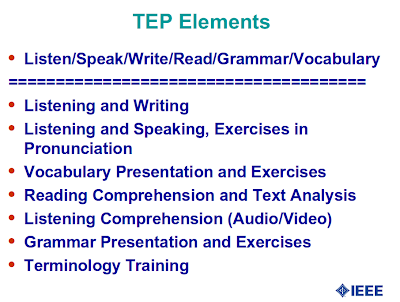English Program for Mathematics Education students and professors.
This course is based on the Technical English Program (TEP) of the Institute of Electrical and Electronics Engineers (IEEE); but it is directed to Mathematics Education professionals and students.
English as a Second Language (ESL) has a long history. You can find the Wikipedia note here. When one learns a second language young, usually the proficiency is equal to people learning that language as a first language. My daughter learned Spanish and English more or less simultaneously. She is fluent in both; I learned English when I was 12, I am fluent but I have an accent.
Language proficiency is a life long endeavor, words and expressions to learn everyday; but the beginning only takes one step, a natural step, to open one's mouth and getting used to how it sounds, and trying to mimic our peers, if they happened to be native speakers, one eventually will sound like them; nevertheless it is not possible to open one's mouth one good day, and just be fluent. Mathematics, and a foreign language do not have a royal road. From Wikipedia:
``Euclid is said to have replied to King Ptolemy's request for an easier way of learning mathematics that "there is no Royal Road to geometry".[8]
Charles Sanders Peirce, in his How to Make Our Ideas Clear (1878), says, "There is no royal road to logic, and really valuable ideas can only be had at the price of close attention." This essay was claimed by William James as instrumental in the foundation of the philosophical school of pragmatism. Sigmund Freud also famously described dreams as the "royal road to the unconscious".
The phrase was echoed in a modern context in the essay No Silver Bullet where Fred Brooks said of software engineering improvements: "There is no royal road, but there is a road."''
